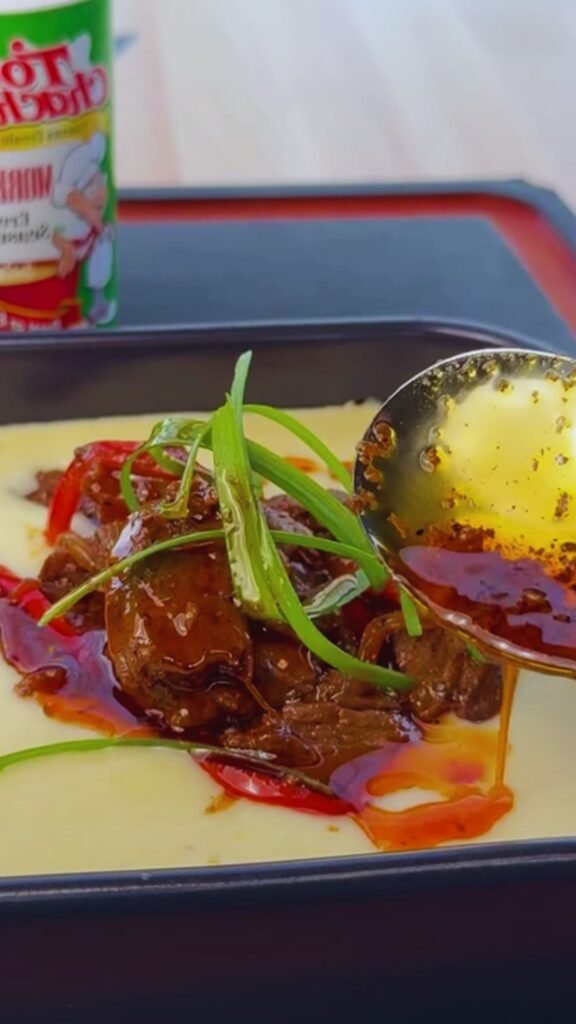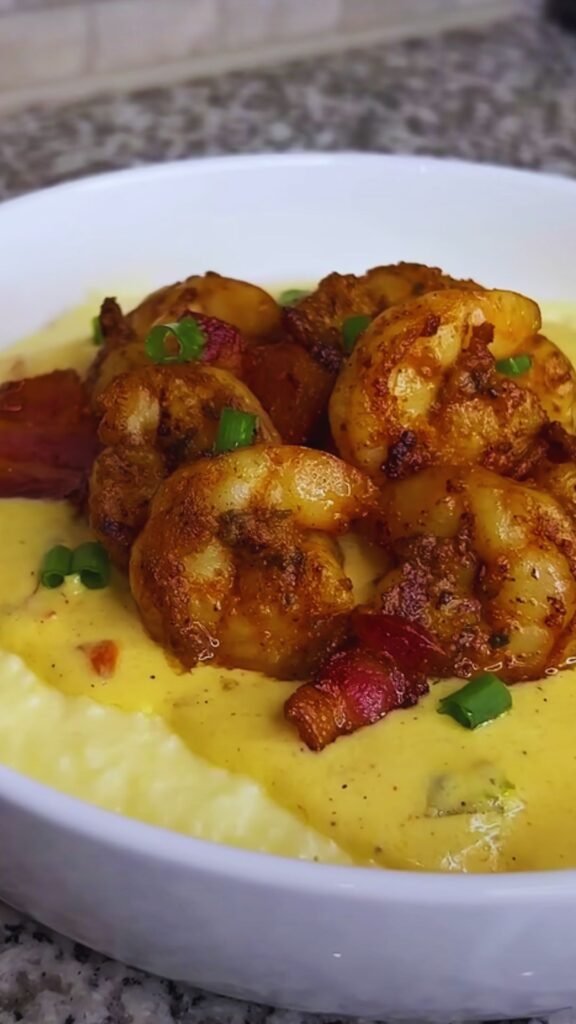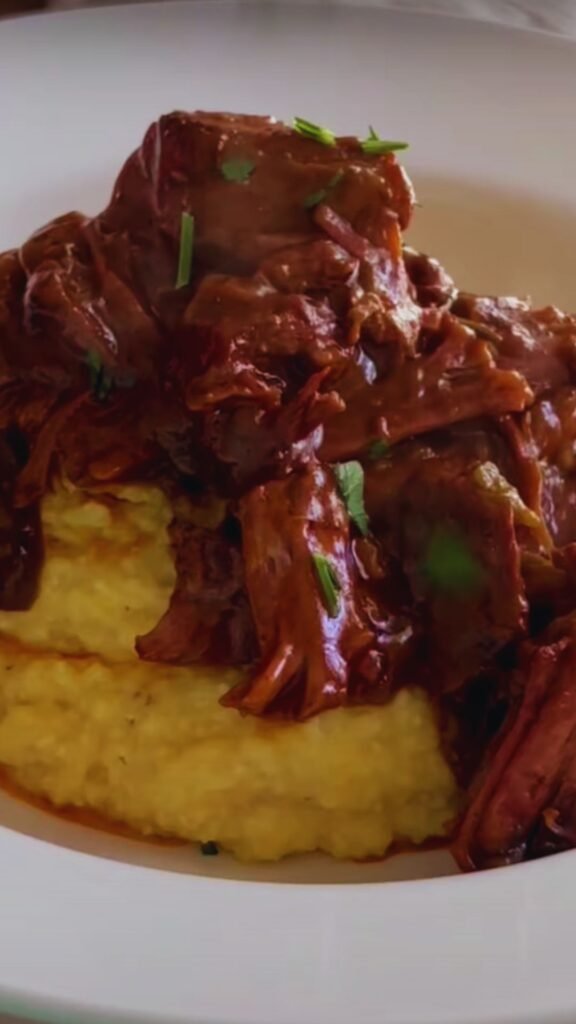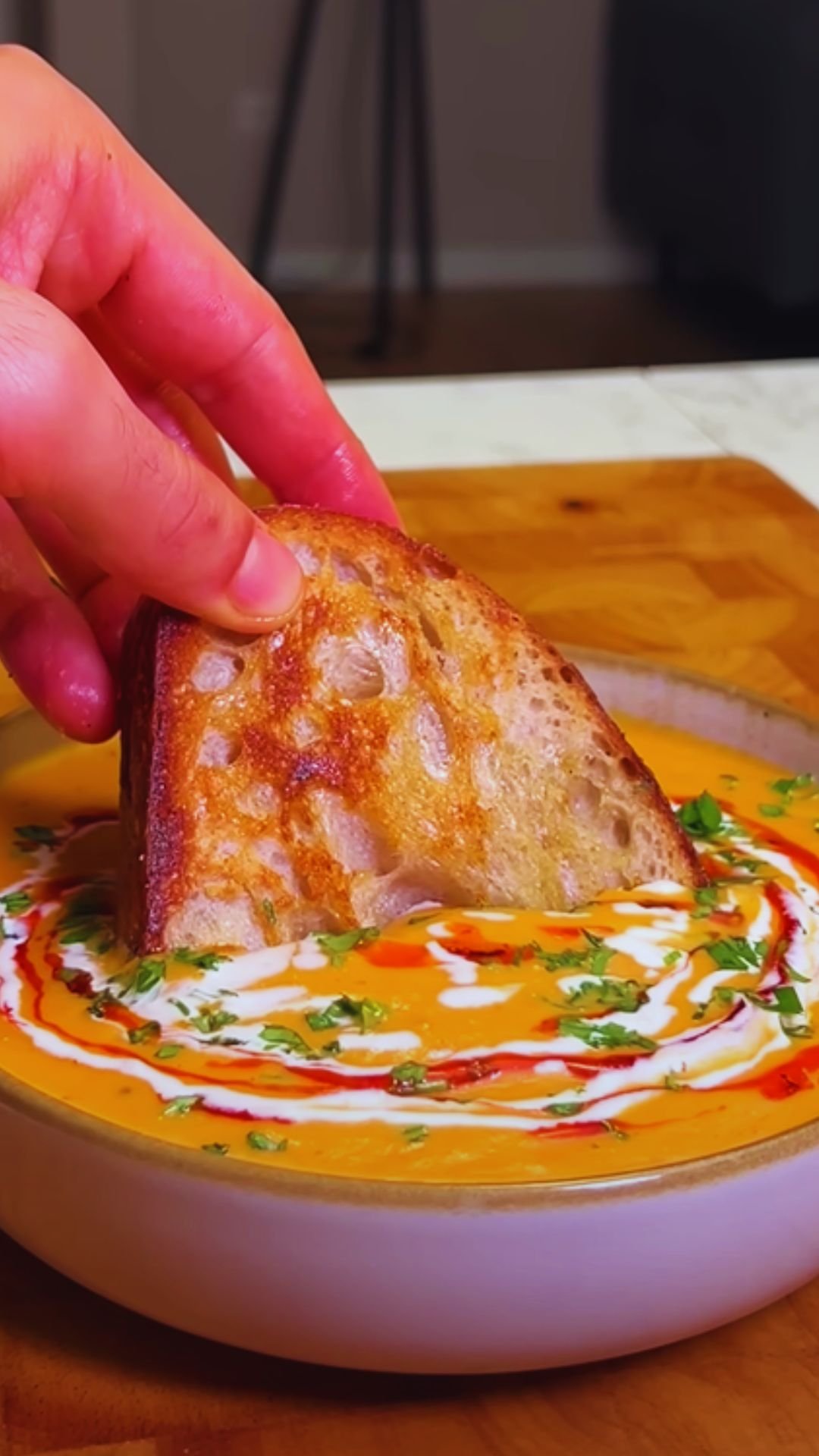There’s something magical about the way a proper bowl of Cajun beef and grits can transport you straight to the bustling streets of New Orleans. I’ve spent years perfecting this recipe, and today I’m excited to share my take on this Southern classic that combines slow-cooked savory beef with creamy stone-ground grits.
The first time I tasted authentic Cajun beef and grits was during a spring visit to the French Quarter. I remember sitting at a small corner restaurant, watching the world go by as I savored each spoonful of this comforting dish. The complex flavors, the perfect balance of spice, and the hearty satisfaction it brought have stayed with me ever since.
This dish represents everything I love about New Orleans cuisine – bold flavors, respect for tradition, and that special something that makes you want to laissez les bon temps rouler (let the good times roll)! Whether you’re cooking for a special Sunday brunch or looking to bring some Southern comfort to a weeknight dinner, this recipe is guaranteed to impress.
The Rich History Behind Cajun Cuisine
Before we dive into the cooking, let’s take a moment to appreciate where this amazing culinary tradition comes from. Cajun cuisine originated with the Acadian settlers who were exiled from Canada in the 18th century and settled in Louisiana. These resourceful people adapted their cooking methods to the ingredients available in their new home, creating what we now know as Cajun cuisine.
Grits, a staple in Southern cooking, were originally a Native American dish made from ground corn. When combined with the French-influenced Cajun cooking techniques and spices, the result is a beautiful cultural fusion that tells the story of America’s diverse culinary heritage.
What makes Cajun cooking unique is its emphasis on what chefs call the “holy trinity” – bell peppers, onions, and celery – along with that signature spice blend that gives dishes their distinctive kick. My recipe honors these traditions while adding a few personal touches I’ve developed over the years.
Essential Ingredients for Authentic Flavor
When preparing Cajun beef and grits, quality ingredients make all the difference. Here’s what you’ll need:
For the Cajun Beef:
- 2 pounds beef chuck, cut into 1-inch cubes
- 3 tablespoons Cajun seasoning (homemade preferred)
- 2 tablespoons vegetable oil
- 1 large onion, diced
- 1 green bell pepper, diced
- 2 celery ribs, finely chopped
- 4 garlic cloves, minced
- 1 jalapeño, seeded and minced (optional for extra heat)
- 2 tablespoons tomato paste
- 1 can (14.5 oz) diced tomatoes
- 2 cups beef broth
- 1 tablespoon Worcestershire sauce
- 2 bay leaves
- 1 teaspoon dried thyme
- ½ teaspoon cayenne pepper (adjust to taste)
- Salt and freshly ground black pepper
For the Creamy Grits:
- 2 cups stone-ground grits (not instant)
- 6 cups chicken broth
- 1 cup heavy cream
- 4 tablespoons unsalted butter
- 1 cup sharp cheddar cheese, shredded
- ½ teaspoon garlic powder
- Salt to taste
For Garnish:
- Sliced green onions
- Fresh parsley, chopped
- Hot sauce (Crystal or Tabasco)
Homemade Cajun Seasoning
While you can purchase pre-made Cajun seasoning, nothing beats the freshness and balanced flavor of a homemade blend. Here’s my trusted recipe:
| Ingredient | Amount | Function |
|---|---|---|
| Paprika | 2 tablespoons | Provides color and mild pepper flavor |
| Salt | 1 tablespoon | Enhances all flavors |
| Garlic powder | 1 tablespoon | Adds savory depth |
| Black pepper | 1 tablespoon | Brings heat and complexity |
| Onion powder | 1 tablespoon | Contributes sweet aromatics |
| Cayenne pepper | 1-2 teaspoons | Delivers signature Cajun heat |
| Dried oregano | 1 teaspoon | Adds herbal notes |
| Dried thyme | 1 teaspoon | Provides earthy complexity |
| White pepper | ½ teaspoon | Offers clean, bright heat |
Mix all ingredients thoroughly and store in an airtight container. This blend will keep for up to three months and can be used for countless Cajun dishes beyond this recipe.
Step-by-Step Cooking Method

Preparing the Cajun Beef:
- Pat the beef cubes dry with paper towels and place in a large bowl.
- Sprinkle with 2 tablespoons of Cajun seasoning, ensuring each piece is well coated. Let sit at room temperature for 30 minutes to absorb the flavors.
- Heat the vegetable oil in a large Dutch oven or heavy-bottomed pot over medium-high heat until shimmering.
- Working in batches to avoid overcrowding, brown the beef on all sides, about 3-4 minutes per batch. Transfer browned beef to a plate.
- Reduce heat to medium and add the onion, bell pepper, and celery to the pot. Cook until vegetables soften, about 5-7 minutes.
- Add the garlic and jalapeño (if using) and cook until fragrant, about 1 minute.
- Stir in the tomato paste and cook, stirring constantly, for 2 minutes to caramelize slightly.
- Pour in the diced tomatoes with their juice, scraping the bottom of the pot to release any browned bits.
- Return the beef to the pot along with any accumulated juices.
- Add beef broth, Worcestershire sauce, bay leaves, dried thyme, remaining Cajun seasoning, and cayenne pepper.
- Bring to a boil, then reduce heat to maintain a gentle simmer.
- Cover partially and cook for 2-2.5 hours, stirring occasionally, until the beef is fork-tender and the sauce has thickened.
- Taste and adjust seasonings as needed. Remove bay leaves before serving.
Making Perfect Creamy Grits:
- In a large saucepan, bring the chicken broth to a boil over high heat.
- Gradually whisk in the grits, stirring constantly to prevent lumps.
- Reduce heat to low and simmer, stirring frequently, for about 30-40 minutes for stone-ground grits. (This is much longer than instant grits, but the texture and flavor are worth it!)
- Once the grits have thickened and are tender, stir in the heavy cream, butter, and garlic powder.
- Continue cooking on low heat for another 5 minutes.
- Remove from heat and stir in the shredded cheddar cheese until fully melted and incorporated.
- Season with salt to taste.
I’ve learned from experience that the key to perfect grits is patience and attention. Keep stirring regularly to prevent sticking and burning. If they become too thick during cooking, you can add a little more broth or water to reach your desired consistency.
The Art of Assembly and Presentation

To serve this dish in true New Orleans style:
- Spoon a generous portion of the creamy grits into wide, shallow bowls.
- Create a well in the center of the grits.
- Ladle the Cajun beef and its rich sauce into the well.
- Garnish with sliced green onions and chopped parsley.
- Serve immediately with hot sauce on the side.
The visual contrast between the golden grits and the rich, dark beef stew makes for a stunning presentation that promises the incredible flavors to come.
Making It Your Own: Variations and Substitutions
One of the joys of cooking is adapting recipes to suit your taste and what you have available. Here are some variations I’ve tried over the years:
Protein Options:
- Substitute shrimp for a seafood version (add them in the last 5 minutes of cooking)
- Use chicken thighs instead of beef for a lighter option
- Try andouille sausage for an even more authentic New Orleans flavor
Vegetable Additions:
- Add okra during the last 30 minutes of cooking for added texture and thickening
- Include diced red bell peppers along with the green for color contrast
- Stir in baby spinach just before serving for added nutrition
Grits Variations:
- Use yellow grits for a more pronounced corn flavor
- Add roasted garlic for deeper flavor
- Try smoked gouda instead of cheddar for a subtle smoky note
Nutritional Information
For those watching their macros or curious about what they’re consuming, here’s the approximate nutritional breakdown per serving (based on 6 servings):
| Nutrient | Amount | % Daily Value |
|---|---|---|
| Calories | 675 | – |
| Protein | 45g | 90% |
| Carbohydrates | 42g | 14% |
| Dietary Fiber | 3g | 12% |
| Sugar | 5g | – |
| Fat | 38g | 58% |
| Saturated Fat | 18g | 90% |
| Cholesterol | 155mg | 52% |
| Sodium | 1285mg | 53% |
| Potassium | 780mg | 22% |
| Iron | 4.5mg | 25% |
| Calcium | 220mg | 22% |
Time-Saving Tips for Busy Cooks
I understand that not everyone has 3+ hours to prepare dinner on a weeknight. Here are some time-saving strategies I’ve developed:
- Make-ahead beef: The Cajun beef portion can be cooked up to 3 days in advance and refrigerated. In fact, the flavors often improve with time.
- Slow cooker method: After browning the beef and sautéing the vegetables, transfer everything to a slow cooker and cook on low for 6-8 hours.
- Pressure cooker option: Use a pressure cooker or Instant Pot to reduce beef cooking time to about 35 minutes at high pressure with a natural release.
- Quick-soak grits: If using stone-ground grits, soak them in water for a few hours before cooking to reduce stovetop time by about 15 minutes.
- Prep ingredients in advance: Chop all vegetables and measure out spices the night before to streamline the cooking process.
Serving Suggestions

To create a complete New Orleans-inspired meal, I recommend serving this Cajun beef and grits with:
- A simple side salad with vinaigrette dressing
- Crusty French bread for sopping up the delicious sauce
- Pickled vegetables for acidity and brightness
- Lemonade or sweet tea for an authentic Southern experience
- Bananas Foster for dessert to continue the New Orleans theme
For a more casual gathering, set up a “build your own” station with various toppings like extra cheese, different hot sauces, crispy bacon bits, and roasted corn kernels.
Storage and Reheating Instructions
One of the beauties of this dish is that it often tastes even better the next day, after the flavors have had time to meld. Here’s how to properly store and reheat:
Storage:
- Cool completely before refrigerating
- Store beef and grits in separate airtight containers
- Refrigerate for up to 3 days
- Freeze beef portion for up to 3 months (grits don’t freeze well)
Reheating:
- Beef: Reheat in a saucepan over medium-low heat, adding a splash of broth if needed to restore consistency
- Grits: Reheat over low heat, stirring frequently and adding a bit of milk or water to loosen
- For best results, avoid microwave reheating if possible, as it can cause uneven heating and textural changes
Common Mistakes to Avoid
Through years of making this dish, I’ve encountered several pitfalls that can be easily avoided:
- Rushing the beef cooking time: Tough cuts like chuck need time to break down and become tender. Patience is rewarded.
- Using instant grits: While convenient, they simply don’t provide the same creamy texture and corn flavor as stone-ground varieties.
- Under-seasoning: Cajun cuisine is known for bold flavors. Don’t be shy with the seasoning, but build gradually to suit your taste.
- Not stirring the grits enough: Neglected grits will stick to the bottom of the pan and develop lumps. Stir frequently for best results.
- Overcrowding the pot when browning beef: This leads to steaming rather than browning, which means less flavor development.
Frequently Asked Questions
Can I make this dish less spicy? Yes! The heat level is completely adjustable. Start with half the cayenne pepper in both the Cajun seasoning and the beef mixture. You can always add more heat at the table with hot sauce.
What’s the difference between Cajun and Creole cooking? While both are Louisiana cooking styles, Cajun cuisine comes from rural French Acadian settlers and tends to be simpler with fewer ingredients. Creole cuisine developed in New Orleans with French, Spanish, African, and Caribbean influences and often incorporates more tomatoes and a wider array of ingredients.
Can I use a different cut of beef? Absolutely! Brisket or short ribs would work wonderfully, though cooking times may vary. The key is to use a tougher cut with good marbling that benefits from long, slow cooking.
My grits turned out lumpy. What went wrong? The most common cause is adding the grits too quickly to the boiling liquid or not stirring enough at the beginning. For smooth grits, whisk constantly while gradually sprinkling them into the liquid.
Is there a vegetarian version of this dish? Yes! You can create a delicious vegetarian version by substituting the beef with mushrooms (particularly portobello or king oyster) and using vegetable broth instead of beef broth. The same Cajun seasoning and cooking method will still yield fantastic flavors.
My Personal Connection to This Recipe
I first encountered Cajun cuisine during a road trip through Louisiana, where I was fortunate enough to stay with a local family who taught me their time-honored recipes. What struck me most was how cooking wasn’t just about nourishment but about storytelling and preserving heritage.
Every time I make this dish, I’m reminded of sitting on that porch in Louisiana, learning how the different ingredients came together to tell the story of the region’s history. The African influence in the use of okra, the French techniques in the roux-based sauces, and the Native American contribution of grits – all coming together in perfect harmony.
I’ve since adapted the recipe I learned, incorporating little tweaks and improvements over dozens of attempts to create what I believe is the perfect balance of authenticity and accessibility. This dish has become my go-to for special occasions and has never failed to impress even the most discerning guests.
Final Thoughts: The Soul of New Orleans on Your Plate
There’s something truly special about dishes that connect us to places and traditions. This Cajun beef and grits recipe is more than just a meal – it’s an experience that brings a taste of New Orleans’ vibrant culture right to your dining table.
What I love most about this dish is its ability to bring people together. It’s impossible to rush through a bowl of this rich, complex stew and creamy grits – it demands to be savored slowly as conversations flow and memories are made.
Whether you’re an experienced home chef or trying Cajun cooking for the first time, I hope this recipe brings you as much joy as it has brought me over the years. As they say in New Orleans, “Laissez les bon temps rouler” – let the good times roll!
Don’t forget to share your results with me if you try this recipe. I’d love to hear about your Cajun cooking adventures and any personal touches you add to make this dish your own.


